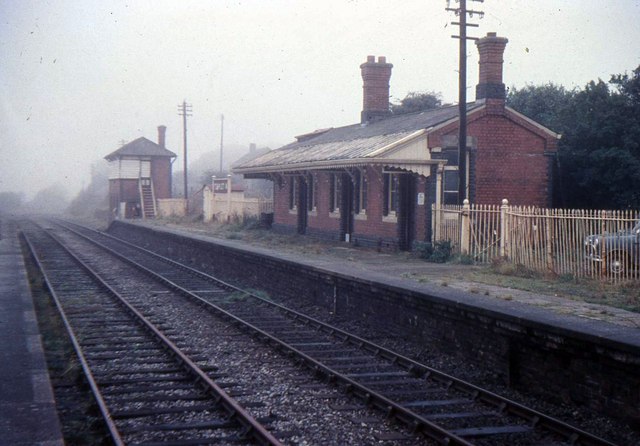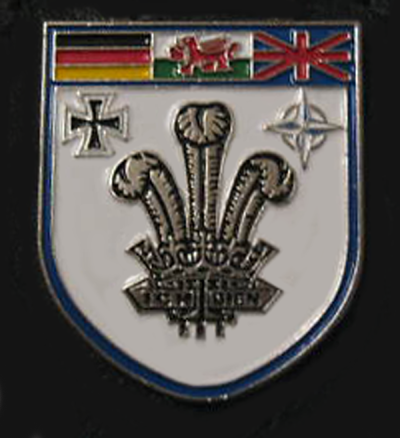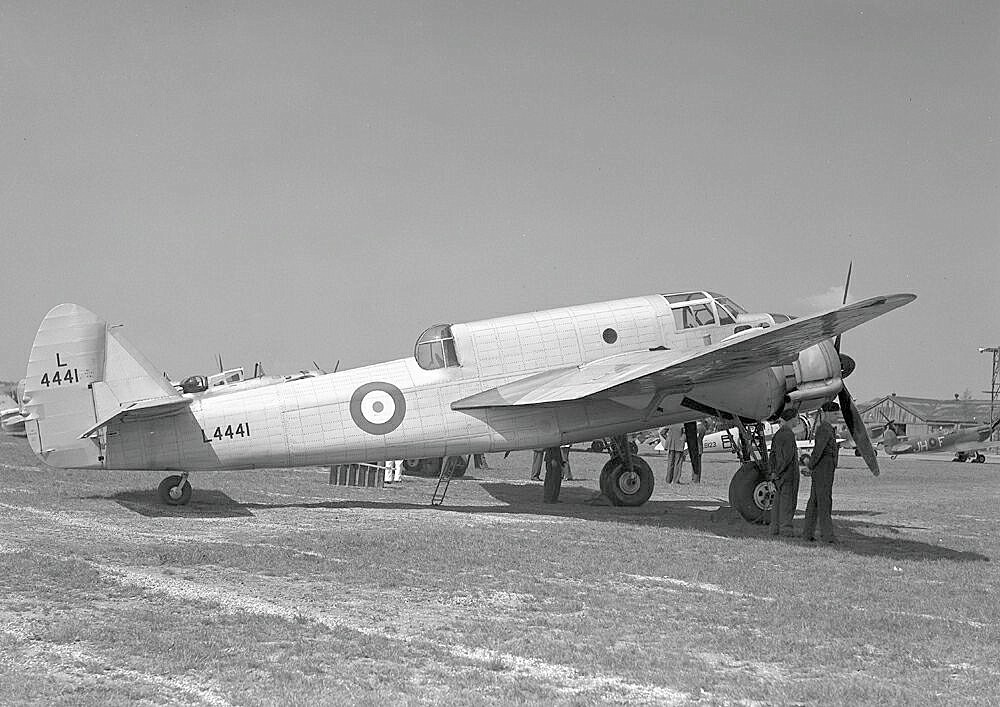|
RAF Templeton
RAF Templeton is a former Royal Air Force station located near Templeton, Pembrokeshire, Wales which was operational between December 1942 and July 1945. It remains in use as Templeton Dry Training Area. History RAF Templeton initially formed part of No. 17 Group RAF, the training organisation within RAF Coastal Command, and had a particular role in training for the defence of the oil installations in Milford Haven. No 306 Ferry Training Unit (Bristol Beaufort) formed at the station in January 1943, later departing to Maghaberry in Northern Ireland. The Observer training flight, "O" Flight, of No. 3 (Coastal) Operational Training Unit RAF (Avro Anson) moved in from nearby Haverfordwest, staying until December 1943. From December 1943 to May 1944, the station hosted an American unit, using British-built aircraft, 1st Gunnery and Tow Target Flight, VIII USAAF, (Westland Lysander and Miles Master) towing targets for the fighters at the American training base at RAF Atcham, Shrops ... [...More Info...] [...Related Items...] OR: [Wikipedia] [Google] [Baidu] |
Templeton, Pembrokeshire
Templeton (Welsh: ''Tredeml'') is a village and community in Pembrokeshire, Wales. The population of the community was 943 in 2011. The built-up area had a population of 627. History Early history The placename Templeton may derive from “The Templar's Farm” or (“Tun”). It is possible that the Knights Templar had some form of religious house here before their possessions were taken over by the Knights Hospitallers, which had a commandery at nearby Slebech, which, by 1282 passed to the Mortimers, Lords of Narberth. In 1282 Templeton was referred to as "Villa temparil" which means the “Vil” or settlement of the Templars and "Villa Templarorium Campestris" – the vil of the Templars in the fields. In 1283 there was also a reference to “Burgesses”. These burgesses were "de vento" - "of the wind" meaning they were not property owners within the settlement but were permitted to come in and out of trade on a regular basis. Burgesses at Templeton are again recorded i ... [...More Info...] [...Related Items...] OR: [Wikipedia] [Google] [Baidu] |
Westland Lysander
The Westland Lysander is a British army co-operation and liaison aircraft produced by Westland Aircraft that was used immediately before and during the Second World War. After becoming obsolete in the army co-operation role, the aircraft's short-field performance enabled clandestine missions using small, improvised airstrips behind enemy lines to place or recover agents, particularly in occupied France with the help of the French Resistance. Royal Air Force army co-operation aircraft were named after mythical or historical military leaders; in this case the Spartan admiral Lysander was chosen. Design and development In 1934 the Air Ministry issued Specification A.39/34 for an army co-operation aircraft to replace the Hawker Hector. Initially Hawker Aircraft, Avro and Bristol were invited to submit designs, but after some debate within the Ministry, a submission from Westland was invited as well. The Westland design, internally designated P. 8, was the work of Arthur ... [...More Info...] [...Related Items...] OR: [Wikipedia] [Google] [Baidu] |
Royal Air Force Stations In Wales
Royal may refer to: People * Royal (name), a list of people with either the surname or given name * A member of a royal family Places United States * Royal, Arkansas, an unincorporated community * Royal, Illinois, a village * Royal, Iowa, a city * Royal, Missouri, an unincorporated community * Royal, Nebraska, a village * Royal, Franklin County, North Carolina, an unincorporated area * Royal, Utah, a ghost town * Royal, West Virginia, an unincorporated community * Royal Gorge, on the Arkansas River in Colorado * Royal Township (other) Elsewhere * Mount Royal, a hill in Montreal, Canada * Royal Canal, Dublin, Ireland * Royal National Park, New South Wales, Australia Arts, entertainment, and media * ''Royal'' (Jesse Royal album), a 2021 reggae album * ''The Royal'', a British medical drama television series * ''The Royal Magazine'', a monthly British literary magazine published between 1898 and 1939 * ''Royal'' (Indian magazine), a men's lifestyle bimonthly * Royal Te ... [...More Info...] [...Related Items...] OR: [Wikipedia] [Google] [Baidu] |
Castlemartin Training Area
The Castlemartin Training Area is located within the Pembrokeshire Coast National Park at Castlemartin, Pembrokeshire, Wales. It is owned by the Ministry of Defence (MoD) and covers The ranges are active for 44 weeks of the year and when in use can include a coastal exclusion zone of as much as off the coast, or as little as depending on which weapon system and ammunition is being used. History The Castlemartin Training Area was established in 1938 from both deserted and inhabited farmland, and from parts of the defunct Cawdor Estate. The ranges were abandoned by the military soon after the Second World War, but were re-instated in 1951 when the Korean War started. In 1961 there was a shortage of suitable tank training areas in the northern part of Germany for the then recently reactivated German Tank Units. The British Army of the Rhine (BAOR) extensively used the ranges at the Bergen-Hohne Training Area which totalled as their training demands could not be met by ... [...More Info...] [...Related Items...] OR: [Wikipedia] [Google] [Baidu] |
De Havilland Mosquito
The de Havilland DH.98 Mosquito is a British twin-engined, shoulder-winged, multirole combat aircraft, introduced during the Second World War. Unusual in that its frame was constructed mostly of wood, it was nicknamed the "Wooden Wonder", or "Mossie". Lord Beaverbrook, Minister of Aircraft Production, nicknamed it "Freeman's Folly", alluding to Air Chief Marshal Sir Wilfrid Freeman, who defended Geoffrey de Havilland and his design concept against orders to scrap the project. In 1941, it was one of the fastest operational aircraft in the world.Bowman 2005, p. 21. Originally conceived as an unarmed fast bomber, the Mosquito's use evolved during the war into many roles, including low- to medium-altitude daytime tactical bomber, high-altitude night bomber, pathfinder, day or night fighter, fighter-bomber, intruder, maritime strike, and photo-reconnaissance aircraft. It was also used by the British Overseas Airways Corporation as a fast transport to carry small, high-value c ... [...More Info...] [...Related Items...] OR: [Wikipedia] [Google] [Baidu] |
Supermarine Spitfire
The Supermarine Spitfire is a British single-seat fighter aircraft used by the Royal Air Force and other Allied countries before, during, and after World War II. Many variants of the Spitfire were built, from the Mk 1 to the Rolls-Royce Griffon engined Mk 24 using several wing configurations and guns. It was the only British fighter produced continuously throughout the war. The Spitfire remains popular among enthusiasts; around 70 remain airworthy, and many more are static exhibits in aviation museums throughout the world. The Spitfire was designed as a short-range, high-performance interceptor aircraft by R. J. Mitchell, chief designer at Supermarine Aviation Works, which operated as a subsidiary of Vickers-Armstrong from 1928. Mitchell developed the Spitfire's distinctive elliptical wing with innovative sunken rivets (designed by Beverley Shenstone) to have the thinnest possible cross-section, achieving a potential top speed greater than that of several contemporary figh ... [...More Info...] [...Related Items...] OR: [Wikipedia] [Google] [Baidu] |
Miles Martinet
The Miles M.25 Martinet was a target tug aircraft of the Royal Air Force (RAF) and Fleet Air Arm (FAA) that was in service during the Second World War. It was the first British aircraft to be designed specifically for target towing. Work on the Martinet was started in response to the RAF's shortage of obsolete frontline aircraft for target towing duties. It was intentionally designed with as much commonality as was feasible to existing production aircraft, being a derivative of Miles' prolific Master trainer. The first prototype Martinet conducted its maiden flight on 24 April 1942, with quantity production commencing immediately thereafter. A total of 1,724 Martinets were produced, of which the majority were operated either by the RAF or FAA, although a minority were also used by overseas and civilian operators. The Martinet was also developed into a relatively secretive aircraft in response to Specification Q.10/43, which called for a radio-controlled target drone. This air ... [...More Info...] [...Related Items...] OR: [Wikipedia] [Google] [Baidu] |
RAF Atcham
Royal Air Force Atcham or more simply RAF Atcham is a former Royal Air Force station located east of Shrewsbury, Shropshire, England, on the north eastern boundary of Attingham Park. Initially built for RAF Fighter Command, during the Second World War its primary use was by the United States Army Air Forces (USAAF) Eighth Air Force. It was mainly the home of the 495th Fighter Training Group, where pilots were trained to fly Republic P-47 Thunderbolts although a few also were trained to fly twin-engined Lockheed P-38 Lightnings for both Eighth and Ninth Air Force units. Atcham continued to see use as a training base until it was returned to the RAF in March 1945. History Royal Air Force The airfield was opened in 1941 and was initially used by the Royal Air Force to house two squadrons of RAF Fighter Command with the first to arrive being 131 Squadron on 27 September 1941 with Supermarine Spitfires It was planned to open RAF Condover as a satellite station but when i ... [...More Info...] [...Related Items...] OR: [Wikipedia] [Google] [Baidu] |
Miles Master
The Miles M.9 Master was a British two-seat monoplane advanced trainer designed and built by aviation company Miles Aircraft Ltd. It was inducted in large numbers into both the Royal Air Force (RAF) and Fleet Air Arm (FAA) during the Second World War. The Master can trace its origins back to the earlier M.9 Kestrel demonstrator aircraft. Following the failure of the rival de Havilland Don as a satisfactory trainer aircraft, the RAF ordered 500 ''M9A Master'' advanced trainers to meet its needs. Once in service, it provided a fast, strong and fully aerobatic aircraft that functioned as an excellent introduction to the high performance British fighter aircraft of the day: the Spitfire and Hurricane. Throughout its production life, thousands of aircraft and various variants of the Master were produced, the latter being largely influenced by engine availability. Numerous Masters were modified to enable their use as glider tows. The Master also served as the basis for the Miles M ... [...More Info...] [...Related Items...] OR: [Wikipedia] [Google] [Baidu] |
Avro Anson
The Avro Anson is a British twin-engined, multi-role aircraft built by the aircraft manufacturer Avro. Large numbers of the type served in a variety of roles for the Royal Air Force (RAF), Fleet Air Arm (FAA), Royal Canadian Air Force (RCAF) and numerous other air forces before, during, and after the Second World War. Initially known as the ''Avro 652A'', the Anson was developed during the mid-1930s from the earlier Avro 652 airliner in response to a request for tenders issued by the British Air Ministry for a maritime reconnaissance aircraft. Having suitably impressed the Ministry, a single prototype was ordered, which conducted its maiden flight on 24 March 1935. Following an evaluation in which the Type 652A bettered the competing de Havilland DH.89, it was selected as the winner, leading to Air Ministry Specification 18/35 being written around the type and an initial order for 174 aircraft being ordered in July 1935. The Type 652A was promptly named after British Admira ... [...More Info...] [...Related Items...] OR: [Wikipedia] [Google] [Baidu] |
Pembrokeshire
Pembrokeshire ( ; cy, Sir Benfro ) is a Local government in Wales#Principal areas, county in the South West Wales, south-west of Wales. It is bordered by Carmarthenshire to the east, Ceredigion to the northeast, and the rest by sea. The county is home to Pembrokeshire Coast National Park. The Park occupies more than a third of the area of the county and includes the Preseli Hills in the north as well as the Pembrokeshire Coast Path. Historically, mining and fishing were important activities, while industry nowadays is focused on agriculture (86 per cent of land use), oil and gas, and tourism; Pembrokeshire's beaches have won many awards. The county has a diverse geography with a wide range of geological features, habitats and wildlife. Its prehistory and modern history have been extensively studied, from tribal occupation, through Roman times, to Welsh, Irish, Norman, English, Scandinavian and Flemish influences. Pembrokeshire County Council's headquarters are in the county ... [...More Info...] [...Related Items...] OR: [Wikipedia] [Google] [Baidu] |
Bristol Beaufort
The Bristol Beaufort (manufacturer designation Type 152) is a British twin-engined torpedo bomber designed by the Bristol Aeroplane Company, and developed from experience gained designing and building the earlier Blenheim light bomber. At least 1,180 Beauforts were built by Bristol and other British manufacturers. The Australian government's Department of Aircraft Production (DAP) also manufactured variants of the Beaufort. These are often known collectively as the DAP Beaufort. More than 700 Australian-built Beauforts saw service with the Royal Australian Air Force in the South West Pacific theatre, where they were used until the end of the war. Beauforts first saw service with Royal Air Force Coastal Command and then the Royal Navy Fleet Air Arm from 1940. They were used as torpedo bombers, conventional bombers and mine-layers until 1942,Robertson 1976, p. 30. when they were removed from active service and were then used as trainer aircraft until being declared obsolete i ... [...More Info...] [...Related Items...] OR: [Wikipedia] [Google] [Baidu] |



.jpg)




